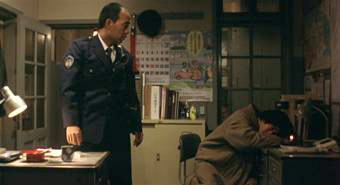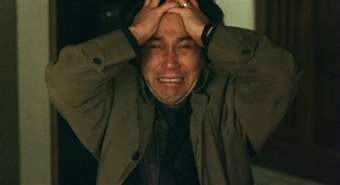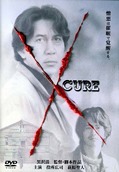In modern day Tokyo, a man walks home, helps himself to a length of water pipe he finds on the way, then for seemingly no reason at all calmly uses it to beat a prostitute to death, after which he carves a large cross in her chest. When the police arrive they discover the man, naked and shaking with fear, hiding in a small utility cupboard.
On a beach in Chiba, a teacher encounters young drifter and possible amnesiac Mamiya, who appears uncertain of his identity or location and is seemingly incapable of effectively processing questions. The teacher takes Mamiya to his house to make further enquiries, only to have Mamiya suddenly begin questioning him about his own life. The next day Mamiya has moved on and the teacher inexplicably kills his wife, cuts a cross in her chest, and hurls himself from an upstairs window.
Kurosawa Kiyoshi is one of the new generation of Japanese directors who are reinventing and reinvigorating the horror film. They appear less interested in the mechanics of plot development than creating an atmosphere of menace that makes even the ordinary and mundane seem threatening. Cure is not a whodunit or a convoluted tale comprised of startling twists, but a chilling, sometimes disturbing mood piece that offers little in the way of clear explanations, but is ripe with suggestion and unsettling inference.

Central to the story are the characters of Takabe, the detective who is investigating the killings, and Mamiya, the young man who, through hypnosis or auto-suggestion, appears to be provoking them. This may seem like a setup for a dark but structurally traditional police thriller, one in which the police repeatedly uncover new information but are always one step behind their prey, until the inevitable breakthrough and the final showdown between detective and killer. And yes, the detective here does use his investigative powers to track down vital clues, and yes, there is something of a showdown between detective and prey in the later stages, but neither play to expectations – Takabe's most effective detective work is done after Mamiya is in custody, and the final showdown provides neither visceral thrills nor any real sense of closure for the detective.
Everything in the film revolves around these two men and their eventual interaction, which doesn't mean we ever really get to know either of them. Mamiya in particular remains a mysterious and almost perplexingly enigmatic figure throughout; is he just a psychology student whose study of hypnosis has driven him off the deep end, prompting him to lose his marbles and encourage others to do likewise, or is there a more supernatural aspect to his being? An unlikely-looking threat, this disheveled, shuffling, seemingly wasted youth was apparently once a functioning member of society, but along the way something has happened to transform him into whatever it is that he has become. One of Takabe's colleagues, searching for an explanation for the killings, offers up the old adage, "The Devil made him do it." Is Mamiya a demon in humdrum, everyday form? Mamiya himself talks at one point of being emotionally inverted – "The things that used to be inside of me are all outside, so I can see all of the things inside of you, but the inside of me is empty."
Early on it becomes clear that Mamiya knows things about people's private lives that he simply shouldn't be privvy to, suggesting an ability to read his victims' minds ("I don't remember it, you do," he tells one of them). But later when he pulls this trick on Takabe, it turns out that he extracted the information from a prison guard, whom Takabe beats senseless for his indiscretion. Takabe is dealing with his own emotional issues in the form of a wife with a deteriorating mental condition, whose symptoms include an inability to recall recent events, and in this way she and Mamiya appear to be quite similar. This increases Takabe's frustration with Mamiya, as the boy's refusal to respond to simple requests reminds the detective all too clearly of issues at home, where his nightly rituals include turning off an empty but steadily rumbling dryer that his wife repeatedly and for no clear reason switches on.

One possibility is that Mamiya is unlocking a closed part of the brain in which our darkest thoughts are kept suppressed, though again this is only alluded to and emerges gradually as the narrative progresses. Having initiated the hypnotic process with the teacher, for example, Mamiya then asks him to "Tell me about your wife," an enquiry that causes the teacher's gaze to falter. Kurosawa cuts away from the scene at this point, but we are left wondering what was hiding behind that look, and just what information the teacher was prompted tosubsequently reveal. As part of a fragmented but innocent-seeming conversation, Mamiya also prompts a beat cop to reveal that sometimes his job is "difficult." We never find out more than that, but this is a middle-aged man with a much younger and more disciplined partner, a man he coldly kills the following morning. Was he resentful of his younger comrade? Was there a reason that he is still a beat cop this late in his career?
But it is Mamiya's encounter with a female hospital doctor that is the most suggestive. This time Kurosawa does not cut away and we watch as Mamiya teases out of her a buried frustration at not having been able to become a surgeon in an all-male world, which the next day takes the form of destructive action. Takabe's increasing frustration at his wife would seemingly make him an obvious candidate for Mamiya to turn into a killer, and part of the tension of the second half comes from the realisation that this could or even should happen. But Mamiya's attempts to hypnotise Takabe are frustrated by the detective's sometimes explosive temper, and it becomes increasingly apparent that he may be facing a different fate.
In the early scenes, the film does play like a carefully paced police drama with horror overtones, but a short while later expectations are overturned – twenty-five minutes in, Mamiya is sitting in a police box (a small, two-man police station) being questioned by concerned beat cop Oida, who witnessed the boy leaping from the roof of a building. That he again turns this around and prompts the policeman to shoot his colleague is not a complete surprise, but that he remains at the hospital and sees through his appointment after being taken there by Oida certainly is. Here he encounters the female doctor and another potential victim, but by then he seems to be deliberately laying a trail for Takabe to follow. There was much talk at the time over the boldness of having John Doe hand himself into the investigating detectives in David Fincher's Se7en when there was still a quarter of the story yet to play, but by the time Mamiya is in police custody as the main link with the killings, we are barely halfway through the film. Clearly Cure is not your ordinary police procedural.
Stylistically, it further distances itself from the genre norm, with Kurosawa's decision to film many key scenes in wide shot and long and sometimes motionless takes giving the film a studied, observational feel that some have misinterpreted as cold detachment. Combine this with the deliberately vague approach to plot points and characterisation and you have a film that is destined to frustrate many viewers. But just as many should take delight in not having obvious and overly famliar narrative development spelled out to them in mile-wide strokes.

Atmospherically, Cure really delivers, with the encounters between Mamiya and his potential victims becoming increasingly unsettling, sometimes purely through the use of sound effects and a dark and sometimes minimalist score, whose deep bass rumbles are sometimes inseparable from the effects track – the meetings between Takabe and Mamiya in the latter's cell in particular have an extraordinary sense of menace. Equally effective is the almost offhand nature of the killings – the two that we see are observed in wide shot and carried out unfussily and without emotion, and there is just enough suggested (the policeman collects a large knife from the police box after shooting his colleague, then starts to drag the body inside for a mutilation we never see) or glimpsed (the partial remains of the teacher's wife are caught briefly as the camera tracks back to the bed from the window through which the teacher has jumped) to suggest something far more unpleasant than Kurosawa has chosen to show. The exception to this is the almost casual discovery of the doctor at work on her first surgery patient on the floor of a public toilet, a genuinely, skin-crawlingly horrific moment that will likely catch even the most prepared of viewers off-guard.
The extremely toned-down approach to characterisation makes the performances secondary to just about everything else, despite the casting of Yakusho Koji (who will familiar to western viewers from his roles in Shohei Imamura's The Eel and Warm Water Under a Red Bridge and Masayuki Suo's Shall We Dansu?) as Takabe, whose sudden bursts of anger seem almost out of place with the overly low key approach elsewhere. This, of course, gives the film's dissenters more ammo – there's not much plot, the characterisations are thin and some of the actors perform as if in a daze. But all of this is intentional, and for my money works most effectively for a film that is not about how police track down a possibly supernatural killer, but the capacity for dark deeds that lies dormant within even the most seemingly well-adjusted and passive individual, and the fragile nature of the emotional and moral core that defines our very nature as 'civilised' beings. It explores the idea that evil, far from announcing itself with leering melodrama, is sometimes so quietly banal that it can pass by almost unnoticed, leaving us only with its consequences and questions about ourselves and our judgment of others. Cure delivers all this and more in a sinister whisper, in a manner that demands but rewards patience and concentration, and remains one of the most genuinely unsettling films I've seen in years.
| sound and vision |
A bit of a mixed bag on the vision front. Though a clean, reasonably sharp 1.85:1 anamorphic transfer, the contrast does tend to wander at times, with some scenes looking very strong and others, especially darker scenes, appearing a little washed out. How much of this is deliberate remains uncertain, but the variation is sometimes not scene by scene but shot by shot. It's a most watchable and at times quite pleasing transfer, but there is still room for improvement here. The heavy leaning towards greens and browns in the colour palette appears to be intentional.
The Dolby 2.0 soundtrack is clear and well mixed, but here is a film just screaming out for a 5.1 or DTS mix – Kurosawa's use of sound is crucial to the film's cut-it-with-a-knife atmosphere, and you just know that if those sinister rumbles were coming at you from every direction and with serious subwooferism then the effect would be even more unnerving. If you have any decent DSP modes on your amp, here is a good chance to see what they can do – redirecting the lower bass frequencies to the subwoofer really has an effect.
| extra features |
Not much here. Biographies of the lead actors are brief, but since they are in Japanese, they will not be much use to anyone not fluent in the language. Other than that there is only the original Japanese trailer, which runs for just over a minute and is anamorphic 16:9 and Dolby 2.0 and similar quality to the film. It ends very abruptly.
| summary |
This Japanese DVD of Cure was given to me as a parting present by two film students when I visited The Japan Academy of Moving Image in Tokyo. They wanted me to watch a key work of a director they greatly admired, but one whose work has been criminally unseen in the West. The problem is clear – Kurosawa tells his story in a way that rejects the Western emphasis on plot and narrative in favour of atmosphere and suggestion, and that's a bastard to market either here or in the US. And yet it received a limited cinema release in America and Home Vision Entertainment released in on DVD there, both to generally positive response. I find it disappointing that none of the UK independent distributors have yet discovered Kurosawa's work – this would be a prime candidate for the born-again Tartan's Asia Extreme label, especially with the quality of the transfers on recent releases and their commitment to DTS sound, which the film is just begging for. We can but hope. In the mean time your best bet is to go for the US region 1 release – the transfer is apparently very good (though the sound is still Dolby 2.0) and it includes an interview with Kurosawa. It's also going to be a lot cheaper than importing this relatively expensive Japanese disk. Whichever one you can get you hands on, though, this is definitely worth seeking out – it is a remarkable, deeply unnerving and atmospheric work that does a splendid job of getting right under your skin, and making it crawl.

